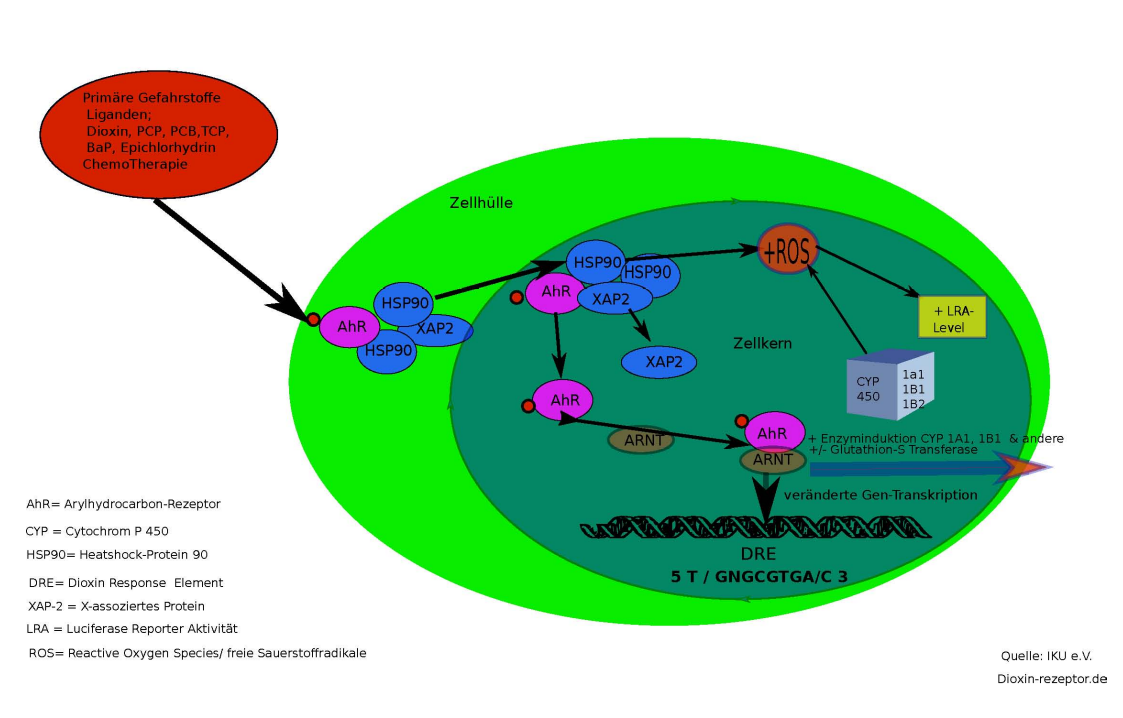First stage: Contact
The so-called aryl hydrocarbon receptor signalling pathway as basic principle for the understanding of the causal relation between hazardous substance and health damage.
According to Wikipedia, the aryl hydrocarbon receptor is a protein found in the cell envelope (cytosol) and the cell nucleus of vertebrate cells that is involved in the control / programming of the gene activity as “transcription factor”.
Simply put, a transcription factor serves to change the gene functions or to transcribe their programs.
As early as at the beginning of the 20th century it was known that certain chemicals, heavy metals as well as radioactive radiation were capable of triggering gene damage. Now we know how this works.
After the aryl hydrocarbon receptor (AhR) has been activated by a corresponding ligand (chemical or heavy metal), it travels together with the toxin from the cell surface to the cell nucleus. Another protein, the “aryl hydrocarbon receptor nuclear translocator” (ARNT) ensures that the AhR can connect to the ligand.
On its way, this trio composed of ligand (dioxin), AhR, and ARNT carries a third protein called heatshock protein 90 (HSP90) to the cell nucleus without binding tightly to it.
Having reached the cell nucleus, the trio separates from the HSP90 and heads for a certain point at the double helix of our genome, called Dioxin Response Element (DRE). Note: Some authors refer to DRE as “xenobiotic responsive element” (XRE).
Having reached the DRE or XRE, the AhR / ARNT / ligand trio docks with the dioxin response element and thereby causes a genetic program change corresponding to the potential of the hazardous substance / ligand. The genetic program change is part of our detoxification system.
On the one hand the massive activation of the Ah receptor results in a negative change of both the genetic constitution in the area of the glutathione-S-transferase (GST) and its enzyme activity, i.e., this latter is permanently downregulated in case of a correspondingly strong (dioxin) exposure.
On the other hand, a massive increase of the enzyme activity in the area of the cytochrome P450 entails a likewise massive production of free oxygen radicals (Reactive Oxygen Species - ROS).
The same is true for the heatshock protein 90 that had travelled from the cell envelope to the cell nucleus together with the AhR / ARNT / ligand trio. This protein too, primarily induces the distribution of free oxygen radicals.
Free oxygen radicals are extremely reactive.
The organism uses this fact by opposing hazardous substances such as polycyclic aromatic halogen hydrocarbons or halogen hydrocarbons consisting of - as their names suggests - long-chain hydrocarbon compounds to free oxygen radicals.
The contact with free oxygen radicals causes a break of these long-chain compounds into shorter ones that are much less toxic and can now be metabolized by the (human) organism via the liver and then be eliminated via the kidneys or faeces.
However, there are two snags:
First: Unfortunately, the free oxygen radicals are incapable of breaking pentachloro dibenzodioxin (PeCDD) or Seveso dioxin TCDD.
Second: The chronic increase of cytochrome P450 and the presence of the heatshock protein 90 entails a permanent increase of the free oxygen radicals, which subsequently leads to further genetic changes, i.e., severe health damage, particularly in the area of the immune system (autoimmune diseases) and the pathogenesis of cancer.
Start AhR signalling pathway




